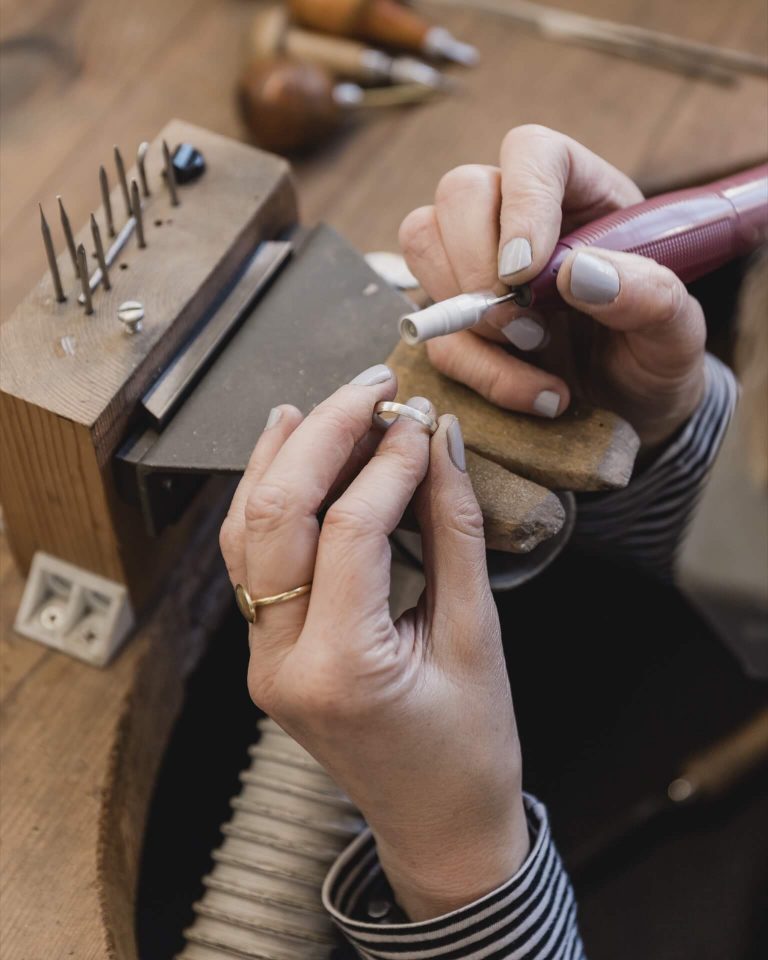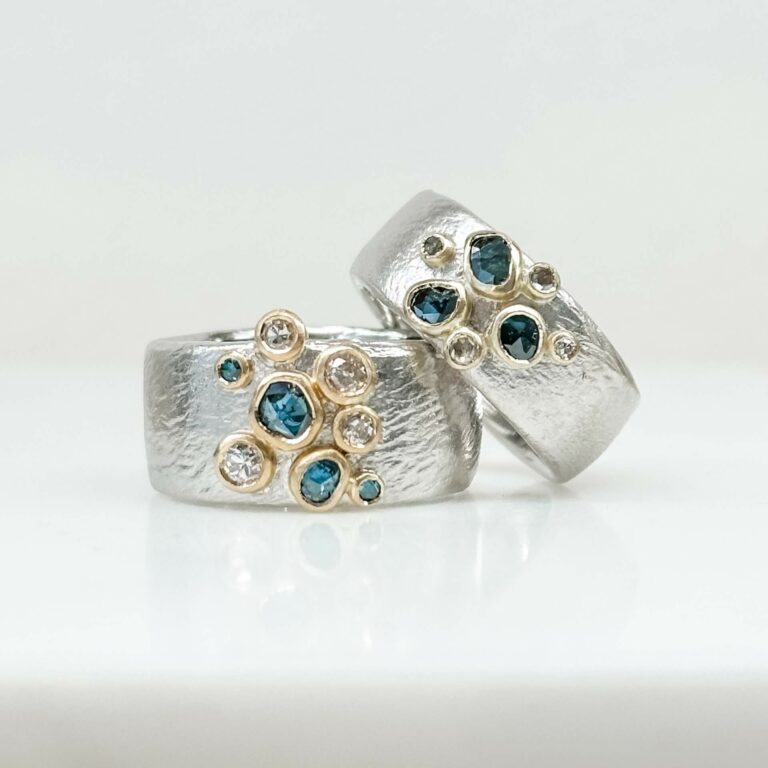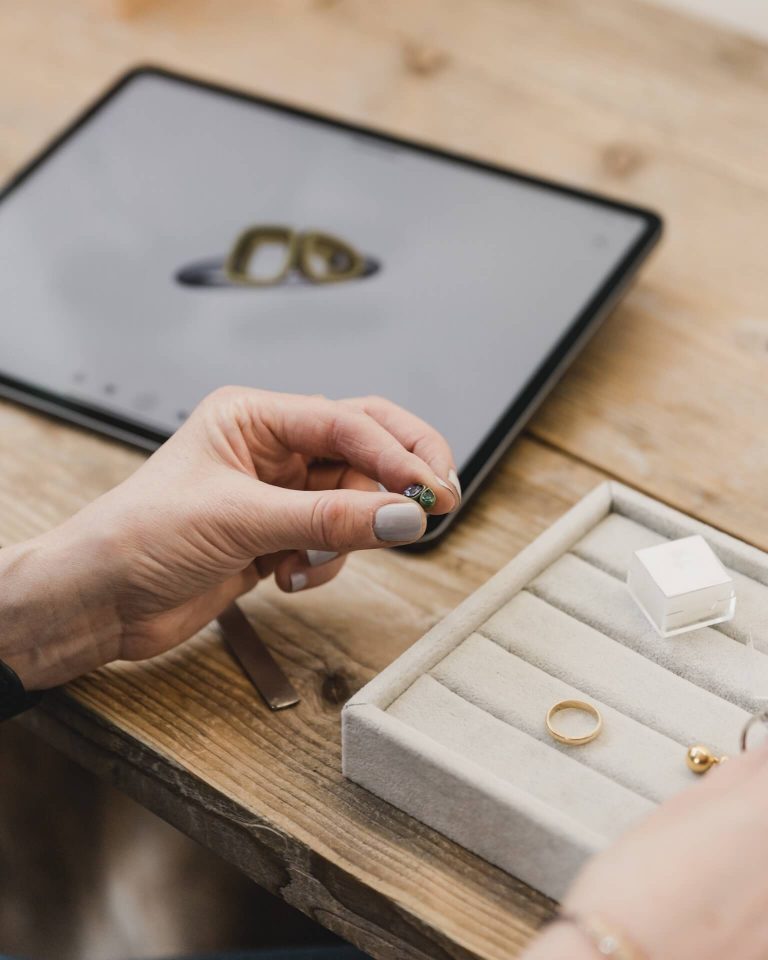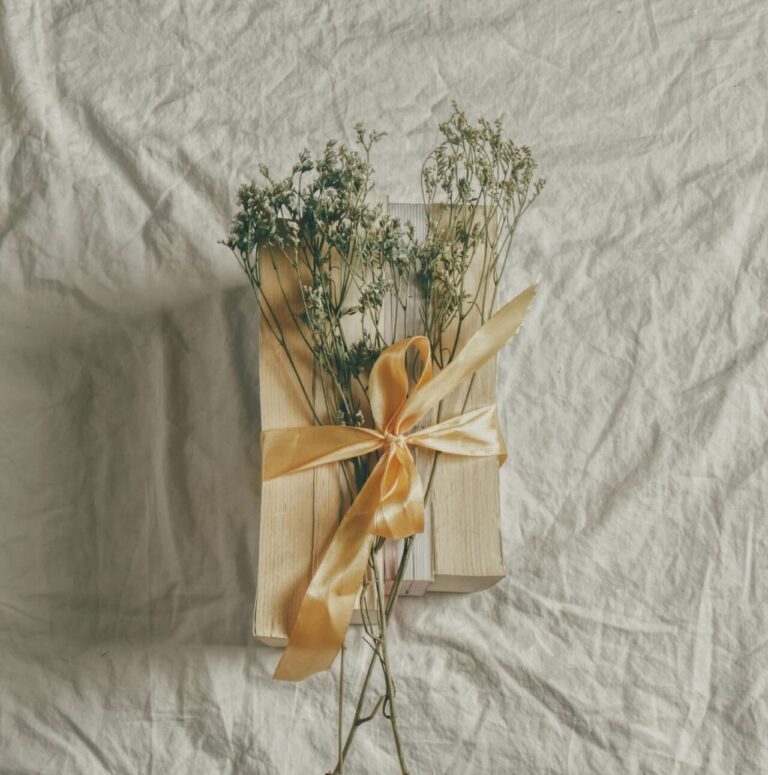Planning a proposal is such an exhilarating time – this will be a moment that you and your partner remember for the rest of your lives, and you want it to feel just right.
The perfect engagement ring can really add to the magic of a proposal, creating that ‘meant to be’ feeling.
Choosing an engagement ring might sound simple on the face of it, but there’s an overwhelming number of results when you search ‘engagement ring’ online. It can be difficult to know where to start, especially if you’ve never bought a ring before or are generally unfamiliar with jewellery.
But fret no more – we’ve created an easy-to-follow guide with tips from a professional engagement ring designer, with a few important elements to consider during your exciting search.
1. Work out your engagement ring budget
There is a tradition of spending twice your monthly wages on an engagement ring, but that isn’t something you need to adhere to – it’s far too much pressure, and it’s totally acceptable to not want to spend so much.
Start by figuring out what you feel comfortable spending on an engagement ring as well as what you can afford, and work from there.
And remember, the wonderful act of proposing to the love of your life means far more than how much money you spend.
2. Think about your partner’s style
Next up, it’s time to pay close attention to your gorgeous partner and what they like to wear, especially when it comes to jewellery.
Do they tend to be a bit more extravagant, unique and bold with their style, or are they more minimalist, wearing jewellery that’s simple and refined? Would your partner prefer a solitaire style engagement ring (one gemstone), tou et moi (two gemstones), or a trilogy ring?
There are so many styles – from Victorian-style gothic engagement rings to contemporary, minimal engagement rings – with lots of different sparkly jewels and gemstones.
Having a feel of whether you want an unusual showstopper of an engagement ring, or a refined and classic engagement ring will immediately narrow down your search.

3. Decide on the metal for your engagement ring
Now that you’ve had a snoop in your partner’s jewellery box and thought about what they wear, you should have a good idea of whether they have a preference for silver or gold jewellery.
If you’re going for a gold engagement ring, the carat (ct) of gold is something to consider. Carat refers to the purity of gold, and assay refers to the testing of a metal to determine its purity, which is stamped onto the jewellery – known as the hallmark.
For example a 9ct assay mark 375 means there is 37.5% gold with 62.5% other metals, and an 18ct assay mark 750 means there’s 75% gold with 25% other metals.
If you’ve decided on a platinum engagement ring, it’s slightly more straightforward, as platinum is only one purity, with an assay mark of 950. It is the purest of all the metals, which makes it very desirable.
You can also opt for a sterling silver engagement ring, which can usually be found for a lower price than a gold or platinum engagement ring. It’s worth noting that sterling silver engagement rings will tarnish over time, and require a little more upkeep to keep them looking their best.
Most jewellers would recommend gold or platinum for an extra special ring which will be worn every day. Jacks Turner makes engagement rings in 9ct and 18ct gold (yellow gold, red/rose gold and white gold), and platinum.

For Jacks’ engagement rings, she generally uses the rubover stone setting, or bezel setting as it is also known. This setting places the gemstone in a border of metal, which is then folded all around the stone to lock it in place.
When complete, the stone is surrounded by metal, creating a halo effect. You can use any precious metal for this style of setting, as it surrounds the gemstones and gives them added protection from knocks and wear.
If you or your partner prefers the claw setting (where the stone is held by little prongs, allowing the sides of the stone to be seen) then Jacks would recommend using harder-wearing precious metals, like platinum, or 18ct white gold and yellow gold.
9ct white gold and sterling silver are not recommended for a claw setting, as the metal is softer – it wears and bends more easily, which could end up loosening the stone.
4. Choose a gemstone for your engagement ring
A diamond is a traditional element of an engagement ring, but it’s not a necessity – you could go for a coloured stone such as an emerald or sapphire if it’s more your partner’s vibe.
Generally, Jacks would recommend diamonds, rubies or sapphires for an engagement ring, as these stones have a scale of 8 and above on the Mohs scale of hardness – a scale from 1-10 that measures a mineral’s resistance to scratch.
Read our other blog, 6 engagement ring gemstones that aren’t diamonds to give you some alternative gemstone ideas.
If you are opting for a diamond engagement ring, the criteria to consider are the Diamond 4Cs, which refers to the cut, colour, clarity and carat.

Cut
Cut refers to the shape of the diamond and the quality of the cut, symmetry and polish of the facets that form the shape of the diamond. Facets are the angles cut into a rough diamond to get the best light refraction, which makes it sparkle.
Cut is measured on a scale of Poor to Excellent, and takes into account the brightness, the fire (the scattering of white light into the colours of the rainbow) and the scintillation (the amount of sparkle a diamond produces, and the pattern of light and dark areas caused by reflections within the diamond).
Cut doesn’t influence the cost so much, so it’s recommended to stay in the Excellent to Very Good range.
Jacks tends to use rounds, ovals, marquise and pear shaped diamonds in her engagement rings, but she also likes the more unusual asymmetrical slices and hexagonal shapes.
As you can see from the diagram, there are many diamond shapes to consider and it is up to personal taste what you choose, however, guidance from the designer can help with getting a pleasing balance and composition.

Colour
Diamond colours are measured on a D-Z scale – D is completely colourless, and Z has a slightly yellow hue. Which you choose depends totally on personal preference as well as your budget. Standard diamond quality falls within the D-J colour grade.
Due to the cut, a round diamond will hide colour, and so gives the option to go further down the scale, while still having a diamond that appears colourless.

Clarity
This refers to the natural imperfections in a diamond, also known as inclusions. The clarity is measured with the Gemological Institute of America (GIA) grading scale, which rates diamonds from flawless (FL) to included (I).
Bear in mind that a stone does not have to rate as flawless for it to look perfect – most inclusions cannot be seen with the naked eye (also known as ‘eye-clean’).
An SI1 (slightly included) is on the lower end of the scale, but can appear beautifully eye-clean – and it’ll cost a lot less than a diamond higher on the clarity scale.

Carat
The origin of the modern carat system for diamonds started as weighing gems with carob seeds as counterweights to balance the scales. These days, one carat is universally equal to 0.2g.
One carat is subdivided into 100 points, allowing for very precise measurements. A diamond may be described as a 50 pointer, which would weigh 0.50 carats (half a carat), and so on.
How many carats to go for is totally up to you and your partner’s requirements, as well as your budget. It’s important to remember that a diamond’s value is determined using all of the 4Cs, and not just carat weight.
Jacks would recommend a diamond with a good colour and cut quality over the clarity, and the carat is always down to personal style and budget.
It’s also really worth thinking about the source of the diamond, which is something we delve into in another blog post, 6 ways your engagement ring can be made more sustainably.
Make sure to ask your independent jewellery designer for information about their practices – ideally they will be responsible and transparent, using conflict-free diamonds sold through the Kimberly process or from a traceable mine.
5. Figure out your partner’s ring size
We gave some insight on determining your partner’s ring size in our previous blog post, 9 sneaky tips for finding the perfect engagement ring for your partner – have a read through if you need some extra help.
If your partner often wears a ring on their ring finger (the one between the little and middle finger on the left hand), pop that ring on your finger, mark where it fits and match that against a ring sizer – you can buy these easily online for a few pounds.
Remember, the fingers on their non-dominant hand will be approximately one size smaller than on their dominant hand.
If you’re unable to get a good idea of their ring size and are worried about buying an engagement ring that doesn’t fit, it’s best to size up and have it resized at a later date.
It feels so much more magical to be able to put the engagement ring on their finger when they say “yes!” and for it to be a little too big, rather than it being too small and not being able to put on their finger at all.
Ring adjusters are a clever gadget to have on hand at the proposal too. A ring adjuster is a small, clear plastic insert or spiral which fits neatly inside the ring or wraps around the band to make it fit more snugly.

6. Find the right jewellery designer for you
Of course, you can walk into a jeweller’s or browse online to buy an engagement ring, but if you’d rather have something a little more unique and personal, you can work with an independent jewellery designer.
Having someone help create an engagement ring to your partner’s desires is really special, and even more so if you’re buying from somewhere that is in some way connected to you or your partner.
It’s so lovely to have an engagement ring with a story – it’s carefully handmade, especially for you – a bespoke engagement ring from an independent jewellery designer your partner loves.
If you think your partner would love to be involved with the design of their engagement ring, but still want the proposal to be a surprise, there is a solution.
Some jewellery designers offer proposal rings – a beautiful stand-in engagement ring, the price of which is then redeemable against your final bespoke engagement ring.
Hopefully that’s helped to map out your engagement ring quest, and make the path look a little clearer. It doesn’t need to be super complicated – as long as you have your wonderful partner in mind, I’m sure the choice will be obvious.
Good luck and happy future engagement to you both!







